Written by: Michael F. Potter and G. Mark Beavers
Lice
Pediculosis is the term used to indicate that an animal or human is infested with lice. These insects are parasites of warm-blooded animals and humans. Lice spend their entire life on their hosts and can only survive off them for 1 or 2 days. Species that feed on animals (like hog lice or cattle lice) may bite humans but cannot live on them.
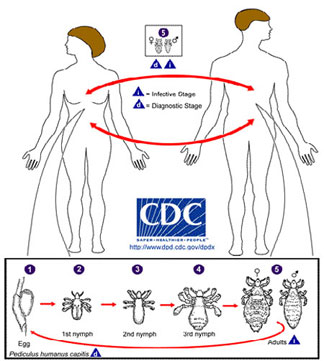
Lice undergo gradual metamorphosis:
egg, 3 stages of nymphs, and the adult (www.cdc.gov)
Three species can be found on humans: head louse, body louse, and pubic louse. All use piercing-sucking mouthparts to feed on blood. Irritation from their bites causes significant itching; movement of the insects on the body is disturbing. Symptoms of long-term infestations are scarred, hardened, pigmented skin resulting from continuous scratching of louse bites. Feeding wounds may become infected from scratching and poor hygiene.
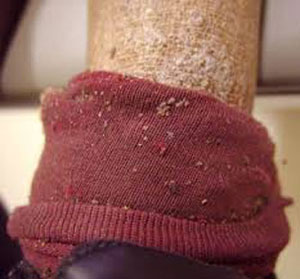
Pediculosis symptoms: hardened, pigmented skin.
Body lice visible on sock. (web.stanford.edu)
The first indication of head lice is itching and scratching caused by the bloodsucking habits of the louse. Examination of the hair and scalp will usually reveal the crawling forms (nymphs and adults) and yellowish white eggs (nits) attached to the hair shafts close to the scalp. Usually all life stages can be seen with the naked eye, although a flashlight and hand lens are helpful. Red bite marks or scratch marks are often seen on the scalp or neck.
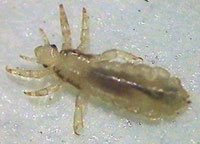 Head lice and body lice must be
Head lice and body lice must be
identified by where they live (www.ces.ncsu.edu)The head louse is by far the most common of the three. Head lice are small (1/12 inch long) insects that are white or gray. Head louse infestations are usually limited to the head, preferring the nape of the neck and the area behind the ears. They move quickly to avoid light making them difficult to see. It may be easier to find nits (louse eggs) glued to the hair than lice, especially if only a few are present in thick, long hair. Nits can be mistaken for dandruff or residues of shampoo. However, nits will not wash off or blow away. The presence of nits does not mean that in infestation is active. It is difficult to tell the difference between a live nit and one from which the insect has already hatched.
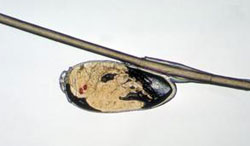 The head louse nit (egg) remains glued to the hair shaft (www.livescience.com)
The head louse nit (egg) remains glued to the hair shaft (www.livescience.com)Head lice are especially common on children between the ages of 3 and 10. In fact, an estimated 10% of elementary school children each year are infested. Large numbers of children come into close personal contact in day cares and schools, where lice may be transferred directly from infested children. Hats and coats are often shared or hung together in the same closet, permitting transfer of lice from one child to another. Transfer of head lice can also occur by using infested combs and brushes, or resting one's head on upholstered furniture or pillows recently used by an infested person.
Body lice and head lice are virtually impossible to tell apart other than by their behavior. Body lice prefer to live in clothing except when they crawl onto the body to feed. Outbreaks of body lice are usually associated with large numbers of people living in close quarters under poor sanitation. Transfer of body lice can occur from shared bedding or clothing.
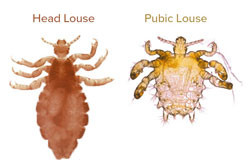 The head/body louse is distinctly different from
The head/body louse is distinctly different from
the "crab" shape of the pubic louse (www.medscape.com)Pubic lice (or crab lice) infestations usually are limited to the pubic area. However, they may also be found on eyebrows, eyelids, or other hairy areas of heavily infested people. They are transferred directly between individuals.
Management and Prevention
While specifics vary, the general principles of lice control are similar for all 3 species. There are four (4) key steps to eliminating head lice and preventing their return:
- The child or infected person(s) should be treated with a medicated shampoo formulated specifically to control lice. Several different products are available through pharmacists and physicians. Follow the directions on the package. Some products require retreatment in 7-10 days. If one family member is found to be infested, all others should be examined. Only those showing evidence of lice should be treated. All infested family members should be treated at the same time to prevent reinfestation from one person to another.
- Remove all eggs using a fine-tooth nit comb. Most louse control shampoos do not kill all the nits. Surviving eggs will hatch within 7-10 days, continuing the cycle of reinfestation. Dead nits also tend to remain attached to the hair, causing uncertainty about reinfestation. Nits are most easily removed by combing while the hair is slightly damp. They can also be picked out with fingernails, or cut out with a small safety scissors.
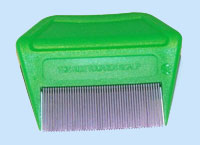
Nit comb (www.stayitchfree.com)
- All personal articles that have been in contact with the infected individual should be deloused. Normal laundering with hot, soapy water (125° F for 10 minutes) or dry cleaning will kill lice and nits on clothing, bed linens, and towels. Combs and brushes should be soaked for 10 minutes in a pan of very hot water. (Note: steps 1-3 should be performed at the same time to avoid reinfestation).
- To reduce the chance of reinfestation, children should be instructed not to share hats, clothing, or brushes with their classmates. Each child should have a separate storage space for hats and other clothing at home and school to prevent contact with other garments. If this is not possible, coats should be hung on hooks so they do not touch, or on the backs of students' chairs.
Elimination of a head lice outbreak in a school, nursing home, or similar shared facility requires prompt, coordinated action and administrative support to prevent the spread of lice to uninfected individuals. Unless all affected persons are treated, the condition will continue.
Treatment of the premises or clothing with insecticides is not required and not recommended for the control and prevention of head, body, or crab lice. The lice cannot survive for any length of time off of their human host.
[return]
Mites
Mites are very small arthropods that are closely related to ticks. Mite larvae have six legs whereas the nymphal and adult stages have eight. Most species of mites are pests of agricultural crops. However, certain types of mites are parasitic on humans.
Chiggers
Chiggers are the larvae of a family of mites that are sometimes called redbugs. The adults are large red mites often seen running over pavement and lawns. Chiggers are extremely small (0.5 mm) and are difficult to see without magnification. The six-legged larvae are hairy and yellow-orange or light red. They are usually encountered outdoors in low, damp places where vegetation is rank and grass and weeds are overgrown. Some species also infest drier areas, however, making it difficult to predict where an infestation will occur.
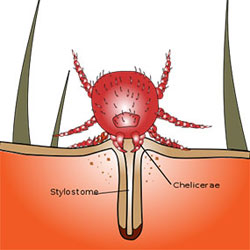 Chigger feeding (www.healthline.com)
Chigger feeding (www.healthline.com)
Chiggers overwinter as adults in the soil, becoming active in the spring. Eggs are laid on the soil. After hatching, the larvae crawl about until they locate and attach to a suitable host. The larvae do not burrow into the skin but inject a salivary fluid which produces a hardened, raised area around them. Body fluids from the host are withdrawn through a feeding tube. Larvae feed for about 4 days and then drop off and molt to nonparasitic nymphs and adults. Chiggers feed on a variety of wild and domestic animals, as well as humans. The life cycle (from egg to egg) is completed in about 50 days.
Most people react to chigger bites by developing reddish welts within 24 hours. Intense itching accompanies the welts, which may persist for a week or longer if not treated. Bites commonly occur around the ankles, waistline, armpits, or other areas where clothing fits tightly against the skin. Besides causing intense itching, chigger bites that are scratched may result in infection and sometimes fever. Chiggers in North America are not known to transmit disease.
Persons walking in chigger-infested areas can be protected by treating clothing (cuffs, socks, waistline, sleeves) or exposed skin with tick repellents. Some repellents should only be used on clothing; and it is important to follow label directions. People who suspect they may have been attacked by chiggers should take a soapy bath immediately and apply antiseptic to any welts. A local anesthetic will provide temporary relief from itching.
Regular mowing and removal of weeds and brush make areas less suitable for chiggers and their wild hosts. Mowing also enhances penetration and performance of miticides, should they be required. Chigger populations can be further reduced by treating infested areas with residual miticides. Applications should be thorough but restricted to areas frequented and suspected of being infested.
Scabies
The sarcoptic itch mites, or scabies mites, infest the skin of a variety of animals including humans. Scabies mites are transmitted by very close personal contact. The types of Sarcoptes inhabiting the skin of mammals are considered different forms of Sarcoptes scabei and they can exchange hosts to some degree. (For example, canine scabies mites can be temporarily transferred from dogs to humans, causing itching and lesions on the waist, chest, and forearms.)
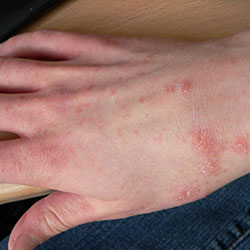 An itchy red rash is the common reaction to a scabies infestation. (www.healthline.com)
An itchy red rash is the common reaction to a scabies infestation. (www.healthline.com)
Human scabies mites are very small (0.30 mm to 0.45 mm long). They commonly attack the thin skin between the fingers, the bend of the elbow and knee. These mites burrow into the skin, making tunnels up to 3 mm (0.1 inch) long. At first, the mites cause little irritation but after about a month an itching sensitization begins. A rash appears in the area of the burrows and the itching becomes intense. Because the symptoms of scabies mite infestations are delayed by about a month, other members of the household besides those showing symptoms may be harboring the mites. It is important that everyone in the infected family or living group go through the treatment regime. A scabies infestation should be handled as a medical problem and is readily diagnosed and treated by most physicians.
Scabies mites can only survive off of a human host for about 48 hours. Therefore, there is no need to treat the premises with an insecticide. However, the clothing and bedding used by infested individuals should be washed in hot water or dry cleaned at the same time the person is treated.
Bird/Rodent Mites
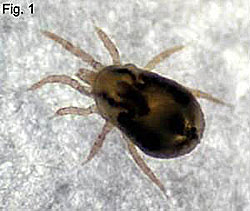 The northern fowl mite is common on many birds that nest in buildings.
The northern fowl mite is common on many birds that nest in buildings.
Bird and rodent mites that occasionally infest buildings are usually associated with wild or domestic birds or rodents. The mites normally live on the host or in their nests, but migrate to other areas of the structure when the animal dies or abandons the nest. Rodent mites often become a nuisance after an infestation of mice or rats has been eliminated. People usually become aware of the problem when they are attacked by mites searching for an alternate food source. Their bites cause moderate to intense itching and irritation. Rodent and bird mites are very tiny, but usually can be seen with the naked eye. They are about the size of the period at the end of this sentence.
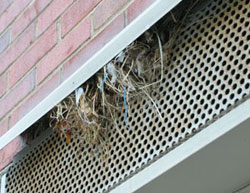 Bird nests on buildings can be sources of temporary mite problems.
Bird nests on buildings can be sources of temporary mite problems.
The first step in controlling bird or rodent mites is to eliminate the host animals and remove their nesting sites. Often, the nests will be found in the attic, around the eaves and rafters, or in the gutters or chimney. Gloves should be used when handling dead animals. A respirator should also be worn when removing nest materials to avoid inhaling fungal spores and other potential disease-producing organisms associated with the droppings.
After nests are removed, the areas adjacent to the nest should be sprayed or dusted with a residual insecticide such as those products labeled for flea control. Space or ULV treatments with non-residual materials (e.g., synergized pyrethrins) can be used in conjunction with residual sprays. Space treatments are especially useful when the mite infestation has dispersed widely from the nesting site. In this case, more extensive treatment with residual and non-residual insecticides may also be necessary in other areas of the structure where mites are observed. A vacuum cleaner or cloth moistened with alcohol can be used to eliminate mites crawling on open surfaces.
[return]
Bed Bugs
 Bed bug (www.extension.umn.edu)
Bed bug (www.extension.umn.edu)
Adult bed bugs are about 1/4-inch long insects with reddish-brown, with oval, flattened bodies. They can live in almost any crevice or protected location. The most common place to find them is the bed or where people sleep. This is especially true during the early stages of a problem. As infestations grow larger, the bugs tend to move beyond beds into other locations making control more difficult. Infestations are usually detected by the welts and irritation caused by the bites, and the fecal smears and blood spots visible on pillowcases, sheets and mattresses. Heavy infestations of bed bugs are also accompanied by a distinct musty odor.
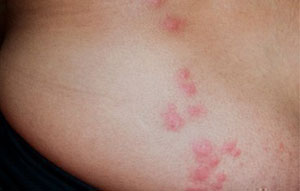 Reactions to bed bug bites vary with the individual. (www.aad.org)
Reactions to bed bug bites vary with the individual. (www.aad.org)
Bed bugs usually bite people at night while they are sleeping. They pierce the skin with an elongated beak through which they withdraw blood. Usually, they are full in 3 to 10 minutes. The bite is painless so the person seldom realizes they are being bitten. Bed bugs do not live on people like head or body lice do, they only visit to feed. When finished, they crawl to a crack or crevice to digest their meal. Both nymphal and adult bed bugs need a blood meal to molt or lay eggs. Bed bugs can survive without a blood meal for about 2 to 6 months in temperature controlled buildings. It is usually impractical to leave buildings unoccupied in hopes of 'starving out' an infestation. When infested dwellings such as apartments are vacated, bed bugs often disperse to nearby units, or reduce their activity until the unit is reoccupied.
Reactions to bites vary from person to person. They may be delayed days or even weeks. This makes it difficult to determine where or when the bites actually occurred. Many develop an itchy red welt within a day or so. Others have little or no reaction. Studies conducted in bed bug-infested apartments suggest about 30% of people do not react even when bitten repeatedly over time. Bed bugs feed on any skin that is exposed while sleeping (face, neck, shoulders, back, arms, legs, etc.). Mosquitoes may be blamed for the welts and itching. Because of this, infestations may go a long time unnoticed, and can become quite large before being detected.
The medical significance of bed bugs is limited to itching and inflammation or infection of their bites. While bed bugs can harbor various pathogens, they have not been shown to transmit them to humans. Bed bugs can substantially reduce quality of life by causing discomfort, sleeplessness, anxiety, and embarrassment. According to some health experts, the added stress from living with bed bugs can have a significant impact on the emotional health and well-being of certain individuals.
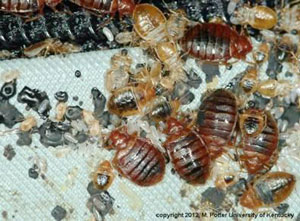 Eggs, nymphs, and adult bed bugs and fecal spots on a mattress (M. Potter, University of Kentucky)
Eggs, nymphs, and adult bed bugs and fecal spots on a mattress (M. Potter, University of Kentucky)
Bed bugs are challenging to eradicate because they can hide in so many places. Inspections must be thorough and elimination is not always a certainty. Whenever resources allow, it's prudent to enlist the services of a professional. Experienced pest controllers know where to look for bed bugs, and have an assortment of tools at their disposal. Nonetheless, owners and occupants can assist the professional in several important ways. Affording access to all living areas is crucial, and excess clutter will need to be removed. Belongings strewn about rooms offer many places for the bugs to hide, and impede inspection and treatment. Since bed bugs can disperse throughout a building, it often will be necessary to inspect adjoining rooms and apartments as well.
Bed bugs are a growing problem in schools and daycares. Typically, they are introduced by students or staff living with an infestation at home. Pinpointing where the bugs exist can be challenging because there may be no or sleeping areas for the insects to congregate. Similar challenges occur when bed bugs are found in offices, libraries and retail stores. Usually, only small numbers of bed bugs are spotted, often on a student's clothing, backpack, chair or desk. While this does not necessarily confirm that the child's residence also has bed bugs, the parents should be notified that the home should be inspected, preferably by a professional. Teachers, nurses, and staff should be educated about the bugs and what they look like. Bed bugs should also be considered if a student frequently has reddened itchy welts; however, such reactions can be for reasons other than bed bugs.
Bed bug incidents in schools are best handled by knowledgeable pest control firms. Widespread insecticide treatment of classrooms, hallways, buses, etc. is unnecessary, ineffective, and imprudent. Effort instead should be spent checking chairs, desks, lockers, coat rooms, etc. in the vicinity of where the bugs were found, and treatment should be focused on those specific areas. Canine inspections can also be useful in finding small numbers of bed bugs in schools and other establishments where there are no beds.
Management
Bed bugs are challenging to eradicate. Since they can hide in so many places, inspections must be thorough and elimination is not always a certainty. Proper preparation for a bed bug treatment is very important, especially when infestations are heavy and the bugs are widely dispersed. More limited preparation may be adequate for light infestations where bed bugs typically are confined to sleeping areas (beds, sofas, and recliners).
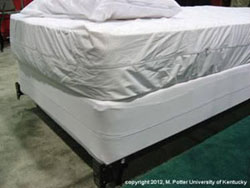 Mattress encasements will trap bed bugs (M. Potter, University of Kentucky)
Mattress encasements will trap bed bugs (M. Potter, University of Kentucky)
Although most furnishings need not be discarded, this may be necessary in some cases. This is especially true of heavily infested beds, sofas and recliners where bugs and eggs often live in hard-to-reach places. Consequently, pest control firms may recommend such items be discarded, especially when in poor condition. When infested items are discarded, bagging or wrapping them prevents dislodgement of bugs enroute to the trash. In the case of beds, a more economical option is to encase both the mattress and box spring in a protective cover like those used for allergy relief.Once the encasement is installed and zipped shut, any bugs which happen to be inside are entombed and eventually will die. These covers help to protect newly purchased beds and make it easier to spot and destroy any bugs residing on the outer surface during subsequent examination. Encasements will not, however, keep bed bugs from crawling onto a bed and biting a sleeping person.
General housecleaning measures, (e.g. vacuuming floors and surfaces), seldom reach where bed bugs hide. Repetitive vacuuming may not be worth the effort, especially compared to other important preparatory activities. Targeted vacuuming of bed bugs and infested harborages, however, can help remove some of the bugs before other treatment measures are undertaken. Bed bugs and especially the eggs can be difficult to dislodge. Optimum results will be achieved by moving and scraping the end of the suction wand along infested areas such as seams and fabric folds of beds and sofas, and the perimeter edge of wall-to-wall carpet. Bed bugs can survive the high speed trip down a vacuum, so it's important to carefully dispose of the vacuum contents in a sealed trash bag afterwards.
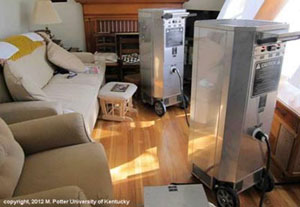 Heat treatments are effective but tend to be more costly
Heat treatments are effective but tend to be more costly
than conventional bed bug treatment methods. (M. Potter, University of Kentucky)
Some pest control firms utilize specialized heating equipment to de-infest furnishings, rooms, and entire dwellings. The procedure involves heating the infested item or area to temperatures that are lethal to bed bugs. The thermal death point is determined by temperature and length of exposure. Bed bugs and their eggs will die after 90 minutes of exposure to 113°F. However, they will die within 20 minutes if exposed to 118°F. Portable heaters and fans are used to gradually heat the air to about 120°-130°F while monitoring with strategically placed sensors. By carefully controlling the temperature, bugs and eggs are killed wherever they may be without damaging household items.
While the methods listed above are helpful, insecticides are widely used by most pest control companies. A variety of EPA-registered materials are available formulated as liquids, dusts and aerosols. Pyrethrins and pyrethroids are the most common compounds used to control bed bugs and other indoor pests. Pyrethrins are botanical insecticides derived from chrysanthemum flowers. Pyrethroids are synthetic chemical insecticides that act like pyrethrins. Unfortunately, some bed bug populations have become resistant to pyrethrins and pyrethroids.
Baits used to control ants and cockroaches are ineffective in this case since bed bugs must bite and feed on blood. Professional-use insecticides tend to be more effective than bed bug sprays sold by retailers. Bleach, alcohol, cigarette lighters, etc. should NOT be used to control bed bugs. Besides being ineffective, such actions can result in fires and other dangerous outcomes.
Insecticide applications require treating all areas where the bugs are found or tend to hide or crawl. This takes considerable effort and follow-ups are usually needed. Companies typically treat seams, folds and crevices of bed components, chairs and sofas but usually will not spray the entire sleeping surface or seating area. They also do not spray bed sheets, blankets or clothing. These items should be hot washed or heated in a dryer.
[return]

